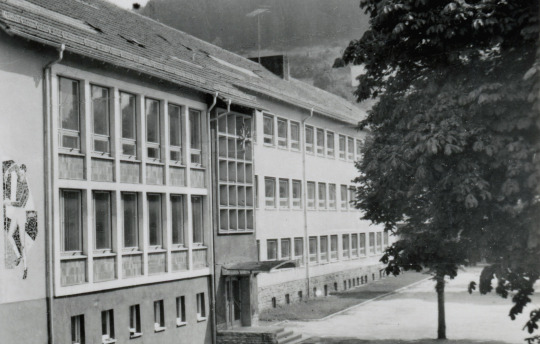#hans fischer
Photo

Marie Maison de Mieux - Pitschi the Kitten (a character from a children book by Hans Fischer)
#plush#plushie#plushies#plushblr#plushcore#toycore#soft toy#stuffies#marie maison de mieux#cat#pitschi#pitschi the kitten#hans fischer#plush: cat
16K notes
·
View notes
Text



Hans Fischer (January 6, 1909 – April 19, 1958)
"Pitschi" japanese edition of Iwanami-publisher.
79 notes
·
View notes
Text


Hans Fischer, Davos Switzerland, 1948
Hans Fischer, Grieder - Bon Genie Fashion Store, 1939
#Hans Fischer#davos#switzerland#travel poster#travel#advertising#commercial art#advertising art#graphic designer#graphic design#graphic art#graphics#modern art#art history#aesthetictumblr#tumblraesthetic#tumblrpic#tumblrpictures#tumblr art#aesthetic#beauty#tumblrstyle
6 notes
·
View notes
Text
Sommer-Eisliebe: Hamburg vom 30.06. bis 09.07.2023
Marion Geyer, Anke Grahlfs, Susanne Lein, Adriana Sanmartin und Rosa Scheffler – Viele kennen diese unermüdlichen und so stilsicheren Designerinnen, Künstlerinnen, und in diesem besonderen Fall auch Kuratorinnen, der seit 23 Jahren in Hamburg legendären Pop-up “Eisliebe”, die allwinterlich auf das Zauberhafteste erlesene, handgemachte Kostbarkeiten präsentiert und zum Kauf anbietet. Das ist…

View On WordPress
#Adriana Sanmartin#angewandte Kunst#Anke Grahlfs#Design#Eisliebe#Hamburg#Handwerk#Handwerkskunst#Hans Fischer#Inspiration#Katrin Aichinger#Keramik#Kunsthandwerk#Miraim Geyer#Orike Muth#Pop-up#Rosa Scheffler#Schmuck#Susanne Lein#Wintereisliebe
0 notes
Photo



The Sehzade Mosque in Laleli, Istanbul (detail), c. 1915. Ludwig Hans Fischer
#The Sehzade Mosque in Laleli Istanbul#art#Ludwig Hans Fischer#Austrian artist#classicism#veduta#architecture#Istanbul#Turkey#artedit#art detail
7K notes
·
View notes
Text

Hans Erich Fischer - Schreitende Katze (1957)
1K notes
·
View notes
Text
Literally always assumed that Indiana Jones and Han Solo are both bi, like ever since being a child and watching those movies on my aunt’s old TV recorded VHS tapes from the 80’s I lowkey assumed that was canon.
Idk why, I guess you put Harrison Ford in a slutty outfit and I’m just like “that’s a bisexual that is!”
#indiana jones#Han solo#Star Wars#bisexual#lgbt media#Harrison ford#queercoding#not to mention my repressed baby dyke self definitely wanted to be Han and Indy growing up so there’s that#gender identity be like: larger than life slutty adventurous characters played by Harrison ford in old movies#gay thoughts#also my gay ass was hopelessly in love with both Karen Allen and Carrie Fischer as a child#still am tbh
20 notes
·
View notes
Photo






sankt dreikönigen // köln bickendorf
the simple reinforced concrete church in the style of the new objectivity with expressionist elements, does not dominate the surrounding settlement like many other churches and thus fits very well into the overall complex. only the church tower is visible from almost everywhere and is a good landmark.
architects: paul bachmann, heinrich forthmann & hans peter fischer
completion: 1929
#neue sachlichkeit#new objectivity#neues bauen#weimar republic#bickendorf#köln bickendorf#cologne#nrw#rhineland#design#modern church architecture#sankt dreikönigen köln#paul bachmann#heinrich forthmann#hans peter fischer#architecture#photography#architecture photography#urban#urban photography#concrete#expressionism#expressionist architecture
55 notes
·
View notes
Text



Ansichtskarte
Wasungen / Werra
Neue Schule.
Meinigen: Kunstanstalt Straub & Fischer Meiningen (V 11 50 S 4/74 Reg. Nr. 23).
1974
#Wasungen#Bezirk Suhl#Schule#Hans Hattop#Kunstanstalt Straub und Fischer#Philokartie#DDRPhilokartie#Architekturphilokartie#BaubezogeneKunst#KunstAmBau#HansHattop#DDRArchitektur#SocialistArchitecture#SocialistArt#DDRKunst#Ansichtskartenfotografie#AnsichtskartenfotografieDerDDR#deltiology#VintagePostcard#SchulbauDerDDR#bbkDDRWasungen#bbkDDRThüringen
14 notes
·
View notes
Photo

Sophie Scholl to Lisa Remppis, München, February 17, 1943; in Hans Scholl und Sophie Scholl. Briefe und Aufzeichnungen, Edited by Inge Jens, Typography and layout by Otl Aicher, S. Fischer Verlag, Frankfurt am Main, 1984, p. 238 [plus At the heart of the White Rose. Letters and Diaries of Hans and Sophie Scholl, (1984), Edited by Inge Jens, Translated from German by J. Maxwell Brownjohn, Preface by Richard Gilman, Harper & Row, Publishers, New York, NY, 1987, p. 280]
#graphic design#correspondence#book#sophie scholl#lisa remppis#hans scholl#weiße rose#inge jens#otl aicher#j. maxwell brownjohn#richard gilman#s. fischer verlag#harper & row#1940s#1980s
17 notes
·
View notes
Text

My scribble of the scrunkly cat soft toy (Pitschi)
#my art#holm's art#plush fanart#marie maison de mieux#pitschi#hans fischer#the scrunkly#scrunkly cat#doodles
594 notes
·
View notes
Text
45 years ago today,
History was made, in a galaxy far far away 🌌
“Star Wars: Episode 4 - A New Hope”
fan tribute poster by me 🌅🌅🌌🗡
Cheers to the franchise that dares me everyday to dream & create more everyday with the sky as the limit 💫🌌🎨

#star wars#star wars fanart#may the force be with you#may the 4th be with you#luke skywalker#the force is with you#lightsaber#jedi#obi wan kenobi#han solo#leia organa#darth vader#george lucas#mark hamill#carrie fischer#harrison ford#david prowse#james earl jones#death star#rebels#fan art#digital art#fandom#movies#poster#artists on tumblr#space#fantasy#sci fi#fiction
41 notes
·
View notes
Photo

Ludwig Hans Fischer (Austrian, 1848-1915)
The Castle of Vajdahunyad, between 1880 and 1885
Museum of Fine Arts, Budapest
#Ludwig Hans Fischer#austria#austrian#italian#italy#art#european art#classical art#fine art#fine arts#The Castle of Vajdahunyad#europe#europa#western civilization#western europe#classical#landscape
7 notes
·
View notes
Text
#nowplaying#2017#The Sound of my 2017#Karl Jenkins#Max Richard Leßmann#Fischer-Z#Band4Dancers#Banners#Faber#Rainald Grebe#Calogero#Matthias Brodowy#Angelina Jordan#Giaches de Wert#Stile Antico#Ola Gjeilo#Hans Zimmer#kettcar#Lotte#Spotify
0 notes
Photo

The Sehzade Mosque in Laleli, Istanbul, c. 1915. Ludwig Hans Fischer
#The Sehzade Mosque in Laleli Istanbul#art#Ludwig Hans Fischer#Austrian artist#classicism#veduta#architecture#Istanbul#Turkey#artedit
345 notes
·
View notes
Text
'As cinephiles throng to the theaters for Christopher Nolan's latest cinematic marvel, Oppenheimer, there is one aspect of his storytelling that often remains shrouded in mystery — his intricate world of sound. Renowned for his grand-scale filmmaking and unconventional narrative techniques, Nolan's breathtaking visuals have earned him legendary status in cinema. However, it is the underappreciated domain of sound where another facet of his genius lies. Bold and creative, his choices in sound design have garnered both plaudits and criticism. So much so that the conversation found its way into Tom Shone's book, The Nolan Variations. In the book, Nolan expresses his surprise at people's conservatism concerning sound, emphasizing that it is not just dialogue but the entire arsenal of cinematic tools — picture and sound — that tells a story. And Nolan's films show this. Nowhere is it more evident than in his seminal work, Dunkirk, a film that even Quentin Tarantino has hailed as Nolan's "apex mountain." As he ascends to its pinnacle, one aspect of his filmmaking emerges as his ice ax: sound design.
One of Christopher Nolan's primary objectives with sound in his films is to provide viewers with a visceral experience. Just as his visuals have a point of view, so do his sounds. He seeks to place the audience in the characters' ears, allowing them to share their emotional journey firsthand. This approach is evident across Nolan's films. In Tenet, where Nolan was criticized for certain incomprehensible dialogues, he asserted that it was a deliberate creative choice. The water scene featuring The Protagonist (John David Washington) conversing with Andrei Sator (Kenneth Branagh) on a noisy boat comes to mind. In the scene, the dialogue's audibility is less crucial than the audience's immersion in the chaotic ambiance. The audience already knows that Sator is an arms dealer seeking to offload his cargo. The Protagonist is pretending to be an interested buyer but Sator doesn't trust him. The dialogue does not add much to the narrative, but Nolan intends to transport the viewer to the noisy environment experienced by the characters. This sense of immersion pervades Nolan's films, from the masked pilots' dialogues in Interstellar and Dunkirk to Bane's (Tom Hardy) stadium speech in The Dark Knight Rises. Yet, it is in Dunkirk where Nolan deeply ventures into uncharted auditory territory.
'Dunkirk' Depicts the Sounds of World War II
From its opening sequence, Dunkirk sets the sonic tone, masterfully shaping the audience's journey. As British soldiers traverse deserted streets, the sound of strewn pamphlets adds an eerie quality — akin to a ghost town. A soldier branches off to an abandoned shop, scavenging an ashtray for a cigarette butt. In the visual close-ups, the audience hears the ruffling of the cigarette butts intimately — the calm before the storm. Abruptly, another of Nolan's sound wizardry emerges — a gunshot shatters the ambiance, and we hear it with the soldier as if standing beside him. The element of surprise, a hallmark of Nolan's films, resonates throughout Dunkirk. Notably, during a scene with British soldiers inside a grounded boat on the shore, unexpected shots at the vessel surprise both the soldiers and the audience. The sound of metal striking metal, rather than typical gunshots, is a creative choice to mirror the soldiers' experience inside the boat. The visceral impact of it makes you jump out of your seat as if the entire scene is happening right where you are.
Authenticity is another pillar of Nolan's sound design philosophy. If a sound can be achieved in the field, that is the path he follows. In Oppenheimer, Nolan eschewed CGI, filming and recording everything practically to maintain authenticity. In a promotional video for the film, Nolan said that he instead used visual effects to showcase some of the microscopic elements of the nuclear explosion as well as filming ''some giant big bangs out in the desert." Likewise, in Dunkirk, the sound of the sirens on German Stuka dive bombers was recorded in the desert, striving to recreate the original sound based on first-hand accounts. With the original bombers destroyed after the war, the recorded sirens before World War II served as a foundation, enhanced with other layers and desert ambiance. To deliver the scene to the audience, Nolan uses the soldiers as his point of view. First, it's an eerie calmness at the mole. Then distant sirens of the airplanes are heard, and their sound becomes more intense as they approach. As they unleash bombs, you can hear the "Boom! Boom! Boom!" sound as it grows nearer and nearer the soldier whose point of view Nolan has decided to tell the story. The impact of this technique is a shared harrowing experience between the characters and the audience.
Christopher Nolan's Use of The Shepard Tone
But the one sound technique that crowns Nolan's filmography is his manipulation of the Shepard Tone. The Shepard Tone is an auditory illusion that creates the effect of a continually rising or falling pitch. In Dunkirk, Nolan uses this sonic illusion to create an ever-increasing sense of intensity, heightening tension masterfully. Across Nolan's films, this technique weaves its magic — whether in the final kick scene of Inception where Robert Fischer (Cillian Murphy, who also featured in Dunkirk) reconciles with his father in the dream or Arthur's gravity-defying struggles. However, Dunkirk elevates this technique to unprecedented heights. In collaboration with his trusted, renowned composer Hans Zimmer, Nolan employs the Shepard Tone to signify the soldiers' urgency. The ticking clock merged with an ominous soundtrack from the outset forebodes doom, escalating tension. Nolan's obsession with authenticity makes it even more realistic. He recorded his own ticking clock! The result is the Shepard Tone that enhances the spiral of sound in the mix, resembling an ever-rising orchestra. The outcome is palpable tension, gripping the audience and making them cling to their seats during moments like the beach attack by German aircraft or the two soldiers racing against time to deliver an injured comrade to a departing ship.
Christopher Nolan's remarkable use of sound in Dunkirk and his entire filmography offer invaluable insights into the critical role sound plays in filmmaking. By skillfully manipulating techniques like the Shepard Tone and employing authentic sounds, Nolan demonstrates that sound is not merely an afterthought but an indispensable storytelling tool. His ability to create immersive and intense auditory experiences allows audiences to emotionally connect with the characters and be fully engaged in the narrative. As you head to the theaters for Oppenheimer, Nolan shows that sound, when harnessed with creativity and precision, can elevate films to new heights and leave an indelible impact on viewers.'
#Oppenheimer#Dunkirk#Christopher Nolan#Shepard Tone#Tom Shone#The Nolan Variations#Quentin Tarantino#Tenet#John David Washington#Kenneth Branagh#Interstellar#Bane#Tom Hardy#The Dark Knight Rises#Robert Fischer#Cillian Murphy#Hans Zimmer
0 notes